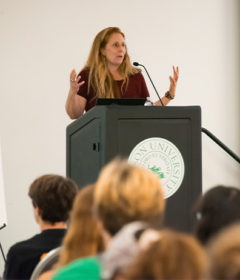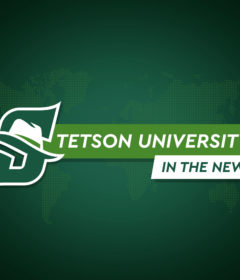SGA Looks for Ways to Improve Hurricane Communication

After Hurricane Irma passed and the University reopened, many students, their parents and others in the Stetson Community asked, “What can we do better” to communicate during severe weather and other emergencies.

Stetson’s communications before, during and after Irma were imperative and, though more efficient than last year’s communication during Hurricane Matthew, still raised a few anxieties over the storm. Seeing online comments and suggestions from students and their families, SGA executive members and invited students met last week to discuss how to address these shared concerns. SGA will take the comments and make recommendations to Stetson’s Emergency Management Team.
Native Floridians are familiar with storm procedures, but the last time we faced a major storm with the strength of Irma was in 2005. Hurricane Wilma struck twelve years ago, when traditional college students were in elementary school. The intervening years can create a laxness about storms that affects Florida natives, out-of-state residents and international students alike. However, in the wake Hurricane Irma’s destruction and the devastation that Hurricane Maria and Harvey wrought on the Caribbean and Texas, respectively, that laxness may give way to panic.
To help, Stetson will be proactive in the future with incoming students, especially working to incorporate hurricane safety preparedness into the FOCUS orientation program for incoming first-year and transfer students. Though Stetson’s official hurricane announcements contained information about measures to take and which supplies to get, there was consensus that training in the beginning of the school year can moderate the alarm that may occur when the campus is under evacuation.
For international and out-of-state students, evacuation can be a complex task. Booking affordable flights, if a flight home was even available, was a common difficulty, along with finding transportation to the airport at a reasonable price. There are resources — not widely known on campus — that need to be actively promoted to students in the future, such as the DOTS shuttle from DeLand to the Orlando, Sanford and Daytona Beach airports.
The university’s evacuation form helped students, who didn’t have a place to go during the evacuation, find a place to stay locally with Stetson community members. Some students questioned why the DeLand campus doesn’t have a building that meets the requirements to function as a shelter during a hurricane. The point was raised that some students, with no place to go, might not feel comfortable going to nearby Volusia County emergency shelters in area schools. In those cases, students must rely on the kindness of other students, faculty, staff and alumni to open their homes. But even if Stetson had a building that would meet the codes, who would staff it? Those issues make a shelter on campus unlikely in the near future. But fortunately, both this year and last year, no students were left behind, without a place to go, when hurricanes struck.
The University kept students, faculty, staff and others informed through email alerts during Hurricane Irma, and the university’s social media also played an important role in reaching mass amounts of people. Student and student organizations shared and reiterated posts and updates that would reach people more immediately than mass emails. However, for those with compromised Wi-Fi or cellular data, receiving that information sometimes was difficult. A point was raised to use the Hatter Alert system to inform students about important updates, such as the evacuation mandate and when residential halls and campus reopen — since cell reception during a storm sometimes is more reliable than getting online.
Some students also questioned why the university didn’t immediately reopen residence halls after the storm, but reopening campus without power, water or clean-up would pose risks that the university is not willing to accept for the safety of its staff, faculty and students.
Chances are Stetson will face more storms in the future. There’s no way to avoid that. The only thing we can do is to be prepared and help each other, as a community, during our times of need.
-SGA Vice President Veronica Faison writes a periodic column about SGA happenings.



